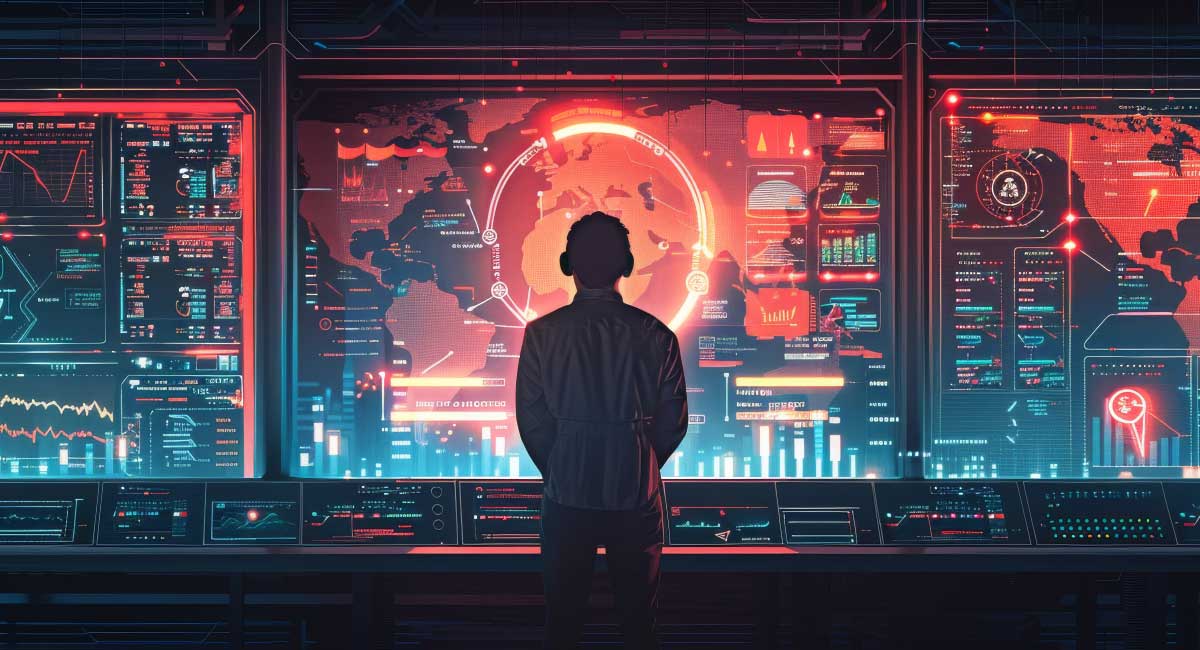“Prevention is better than cure” may be an old adage, but it captures the essence of cybersecurity. Every enterprise embarking on a digital transformation journey grapples with safeguarding its networks and data from malicious attacks. Cybersecurity serves as the guiding beacon for such enterprises.
However, in this ever-evolving field, enterprises require professionals who can stay abreast of cybersecurity trends and drive their implementation within the organization.
This article will outline ten trends expected to shape the cybersecurity landscape in 2025. But before that, we will offer you a brief peek into the threat landscape. We will also discuss the implications of these trends on cybersecurity careers. And finally, we will talk about an industry-recognized cybersecurity program that will help you launch a successful career in this field.
The Evolving Landscape of Digital Threats
Digital threats evolve with digital technologies. The world is going digital, and the advent of AI and ML has further enhanced the dangers. Organizations must know about risks and stay prepared to dismantle them before serious damage occurs. That’s why companies across industries are increasingly serious about hiring cybersecurity professionals who are competent and creative about possible worst-case scenarios in such an evolving landscape. Let us look at the main features of these digital threats.
Diversity of Attack Modes
Digitalization has led to a rise in new ways of breaching security measures. In addition to the traditional methods such as malware and ransomware, digital threats can now be more complex or combined techniques, such as deploying malware through emails, accessing data, and imposing DDoS attacks through credentials stolen from social media photos.
Sophisticated Techniques
Earlier, malware could enter the computer only when one inserted a thumb drive or a CD. Due to the Internet’s widespread use, data access is unlimited. Malicious elements can now utilize multiple tools available anywhere in the world and connect with other such individuals to build a sophisticated setup to breach the cybersecurity gateways.
Government-backed Hacking
Countries have begun to form special hacking groups to attack the critical infrastructure of rival nations. Cyberwarfare is slowly becoming a mainstay with nation-state actors funding advanced cyber technologies. Hence, governments are also working towards strengthening their cybersecurity measures by employing professionals with white-hacking expertise.
Diversity in Targets
In earlier times, malicious attacks targeted industry leaders and major financial institutions. Now, even a small business or an individual can become a victim of cyberattacks. No digitalized operation is immune to such attacks.
Regulatory Compliance
Governments worldwide have established guidelines for enterprises to follow when they source customer data. They often partner with independent institutions to frame laws and regulations that dictate the level of cybersecurity required. Further, enterprises must demonstrate their compliance and get certified to build their credibility in the market.
Collaborative Operations
A great cybersecurity policy involves sourcing information about cyber threats and responses worldwide. You can no longer work solely with historical data. Businesses must partner with multiple entities to anticipate risks and fortify their cybersecurity measures.
Resilient Security Measures
Organizations must become proactive in their approach to tackling cyber threats. More than a passive and defensive protection strategy is required. Cybersecurity measures must have provisions to anticipate threats and implement protective measures in advance. They must develop plans to proactively seek out potential threats and eliminate them before they attack systems.
Increasing Awareness
Awareness among employees and appropriate training is paramount for preventing accidental data leaks. Open communication with the IT department, awareness workshops for employees, and warning pop-ups for users accessing the organization’s network or websites are some of the measures to achieve this. The individuals must know whom to contact in case of a mistake so that the response can be immediately put into action and the disaster can be averted.
Also Read: The Essential Guide to Endpoint Security and Protections
Why It’s Important to Look at Cybersecurity Trends
Cybersecurity trends offer insight into possible dangers that may emerge from upcoming technologies. Cybersecurity professionals can prepare themselves for these threats by assessing the risks their organizations face due to such trends. They must evaluate the existing cybersecurity measures and look for areas to improve. Understanding the trends can also help them analyze additional measures they must implement to prevent further attacks.
Suppose the organization is in the process of installing new technologies. In that case, cybersecurity professionals can observe the trends to narrow down any crucial threat that these technologies may face. They can then design the cybersecurity framework with advanced capabilities and stay one step ahead of malicious elements.
Ten Latest Cybersecurity Trends
Here are the top ten cybersecurity trends that every cybersecurity professional must explore in 2025.
1. Machine Learning (ML) and Artificial intelligence (AI)
ML and AI are here to stay. Hence, understanding their role in cybersecurity is vital for a comprehensive cybersecurity infrastructure. AI and ML can help improve early detection systems by using historical data and predicting future attacks. They can also automate routine security testing, identify threats, and send an immediate response. Further, security bots based on AI will be developed to take proactive actions against network and data threats.
2. Automotive Cybersecurity
In today’s automotive industry, electronics and wireless communication are on the rise, especially with the advent of electric and driverless cars. Hence, the risk of hacking automobiles has emerged as a potential risk. Movie scenes where cars are stolen by copying the electronic patterns of the key demonstrate one such risk. Further, vehicles automatically connected to GPS are in danger of being tracked and their location information being sold.
3. Internet of Things
The Internet of Things (IoT) fosters a greater reliance on the Internet for domestic and household use. For example, robotic mops can be programmed to clean house floors so that one can operate them from one’s office. Such technologies map the contents of homes. Hence, cybersecurity has to be strong enough to prevent the data from being accessed, tapped, and misused.
Also Read: What is Threat Intelligence? Definition, Types, Importance, and More
4. Cloud Security
Data-intensive technologies have led to a proliferation of cloud use for multiple operations and analytics. Because the Internet is an essential factor in cloud usage, cybersecurity measures must be stringent enough to prevent unauthorized access, data manipulation, and information leaks. Hence, cloud service providers and users must have installed sufficient cybersecurity protocols.
5. The Nascent State of 5G Infrastructure
Although the 5G internet is steadily growing, the 5G infrastructure is still nascent and vulnerable to cyber threats. Hence, manufacturers and service providers must implement security measures that require further evaluation and development to ensure appropriate protection. Further, application developers must update their applications considering such 5G threats so that users can easily switch between networks without facing security issues.
6. Attacks on Mobile Devices
Mobile devices have now become a combination of a phone and a mini-computer. In addition to connecting the world via audio, video, and text, they also work as a collection of financial, educational, and gaming applications. All these applications require multiple permissions to access the data on the phone. Such applications can become a source of malware if they are downloaded from unreliable and unknown sources. Hence, mobile security is a cybersecurity trend poised to become a priority for phone manufacturers, app developers, and security software developers.
7. Zero Trust Security
Zero trust security will still be a trending topic in 2025. Zero trust security refers to considering every access request as a potential risk. Thus, the focus is on implementing multiple authentication steps to verify the identity and access credentials. A good example is the PIN sent via text message to log into the bank accounts. Social media sites like LinkedIn have also begun implementing two-step authentication to prevent bots and dummy accounts. Zero Trust security will gain further importance as the scope of remote work and freelancing augments due to the companies sourcing talent worldwide.
8. Social Engineering Attacks
Social engineering attacks are becoming more sophisticated. Malicious elements are targeting individuals via phishing. In addition to sending emails containing malware, they have begun mounting phishing attacks via text and applications such as WhatsApp, Telegram, Facebook, Slack, and Instagram.
SMS and voice call phishing are now called smishing and vishing, respectively. For example, attackers play an official-sounding voice message from courier companies and can trick people into transferring money. They may also send messages stating that a person may lose access to their bank account, sending the person into panic and provoking them to reveal their login credentials. Hence, implementing cybersecurity awareness programs and measures to prevent people from falling prey is a top cybersecurity trend.
9. White Hat Hacking
White hat hacking, commonly known as ethical hacking, refers to testing security measures by purposely breaching an organization’s networks and data. Enterprises will increasingly opt for ethical hacking and bug bounty programs to check the efficacy of their security measures. Multiple enterprises organize hackathons to crowdsource hacking experts.
Also Read: What is IoT Security? Explanation, Importance, Types, and More
10. Cyber Insurance
Enterprises have begun to realize the criticality of cyber threats, as ransomware attacks and data breaches lead to enterprises losing millions of dollars annually. Hence, the development of cyber insurance policies customized to the industry and threats will come to the fore. Such policies will be reframed to include the cost of recovery and refurbishment of the It and cybersecurity infrastructure. Further, there may be customized policies for unique threats.
The Future of Cyber Security and How It Impacts Careers
The future of cybersecurity is ever-evolving and intricate. Cybersecurity professionals must go above and beyond their expertise to predict and anticipate novel modes of cyberattacks. They must devise unusual techniques to withstand cyber threats. In short, they have to be one step ahead of malicious elements.
Thus, this is a golden time for aspiring cybersecurity professionals who want to use their skills ethically. According to the US Labor Department, job opportunities for cybersecurity professionals are poised to grow by 32 percent by 2032.
To join this massive workforce, you must work on carving out a niche for yourself in this dynamic field. Being a part of the crowd is no longer an option. You must choose your area of expertise and work on developing your skills.
Connecting with peers is essential, as the future of cybersecurity involves tremendous global networking. You can no longer rely on existing knowledge. You must be aware of the variety of cyber threats and cybersecurity measures across the globe. In conclusion, cybersecurity requires individuals to constantly update their knowledge, develop their cybersecurity portfolio, and work towards proactively eliminating cyber threats.
Also Read: The Comprehensive Guide to Identity and Access Management (IAM) in Cybersecurity
Learn the Skills to Launch Your Cybersecurity Career
Cybersecurity offers a dynamic and stimulating career path with handsome pay and perks. If you’re ready to start this exciting journey, check out this cybersecurity bootcamp. The online program covers essential concepts such as virtualization technologies, the CIA triad (confidentiality, integrity, availability), and penetration testing. You’ll gain insights into the roles of the red and blue teams, learning network security strategies, network diagrams, encryption methods, and other cybersecurity trends to prepare for.
Led by industry experts, you’ll receive training in digital forensics, identity management, incident response, and vulnerability assessment, preparing you for a successful career in cybersecurity.
You might also like to read:
The Ultimate Guide to Your Cybersecurity Certification Roadmap
AI in Cybersecurity: A Comprehensive Guide
What is Zero Trust Security? Definition, Best Practices, Use Cases, and More






